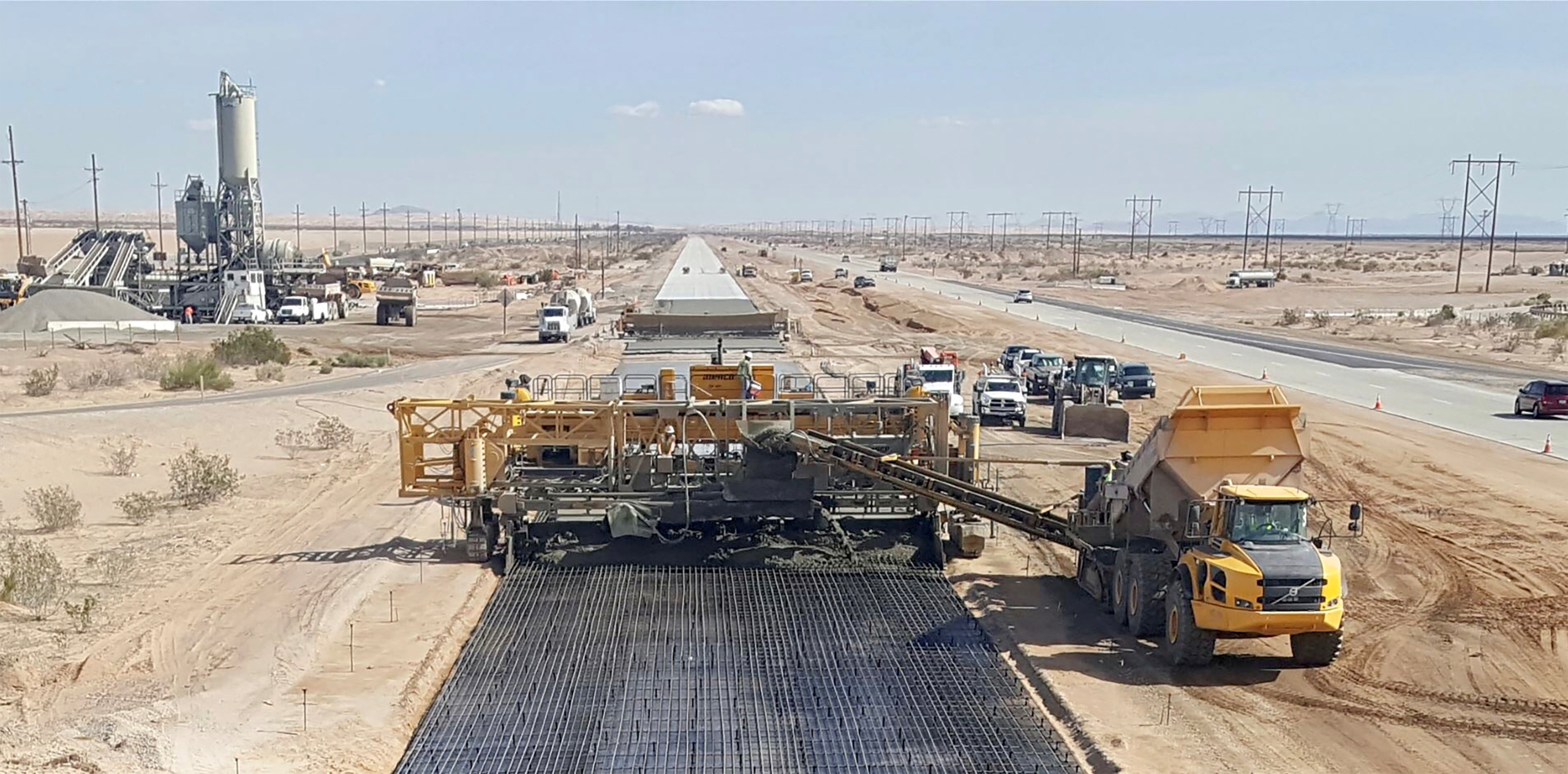Reuse enhances sustainability with more than 200,000 cubic yards of roadway recycled onsite.
By Irwin Rapoport and Mark Gudenas
To reconstruct and rehabilitate 48 mainline miles of Interstate 8 in the eastern part of the Imperial Valley, Caltrans utilized a very innovative approach. For Segments Four and Five of the work, Continuously Reinforced Concrete Pavement (CRCP) overlays were placed on top of the existing 50-year-old, un-doweled, jointed plain concrete pavements – JPCP.
“This was the first big CRCP overlay job in the state,” said Michael Oreiro, P.E., Caltrans Project Engineer for Sections Four and Five, District 11. “We did some smaller areas in L.A. County, but for this many miles and this amount of concrete, this is the biggest. A CRCP overlay had previously been done in Michigan, along with some additional states in the central U.S. and they proved to have a good lifespan. We usually design our concrete projects for a 40-year lifespan. The overlay is a test of the longevity of concrete pavement. It’s pretty much maintenance-free as there are no lateral joints that we have to reseal periodically.”
Oreiro praised Mehdi Parvini, Caltrans Senior Transportation Engineer, who championed the use of a CRCP overlay for the I-8 project. CRCP naturally forms tight transverse cracks to evenly transfer loads. The result is a continuous, smooth-riding surface capable of withstanding the heaviest traffic loads and the most adverse environmental conditions. The life span for CRCP pavement may be up to 70 years, far exceeding current road design.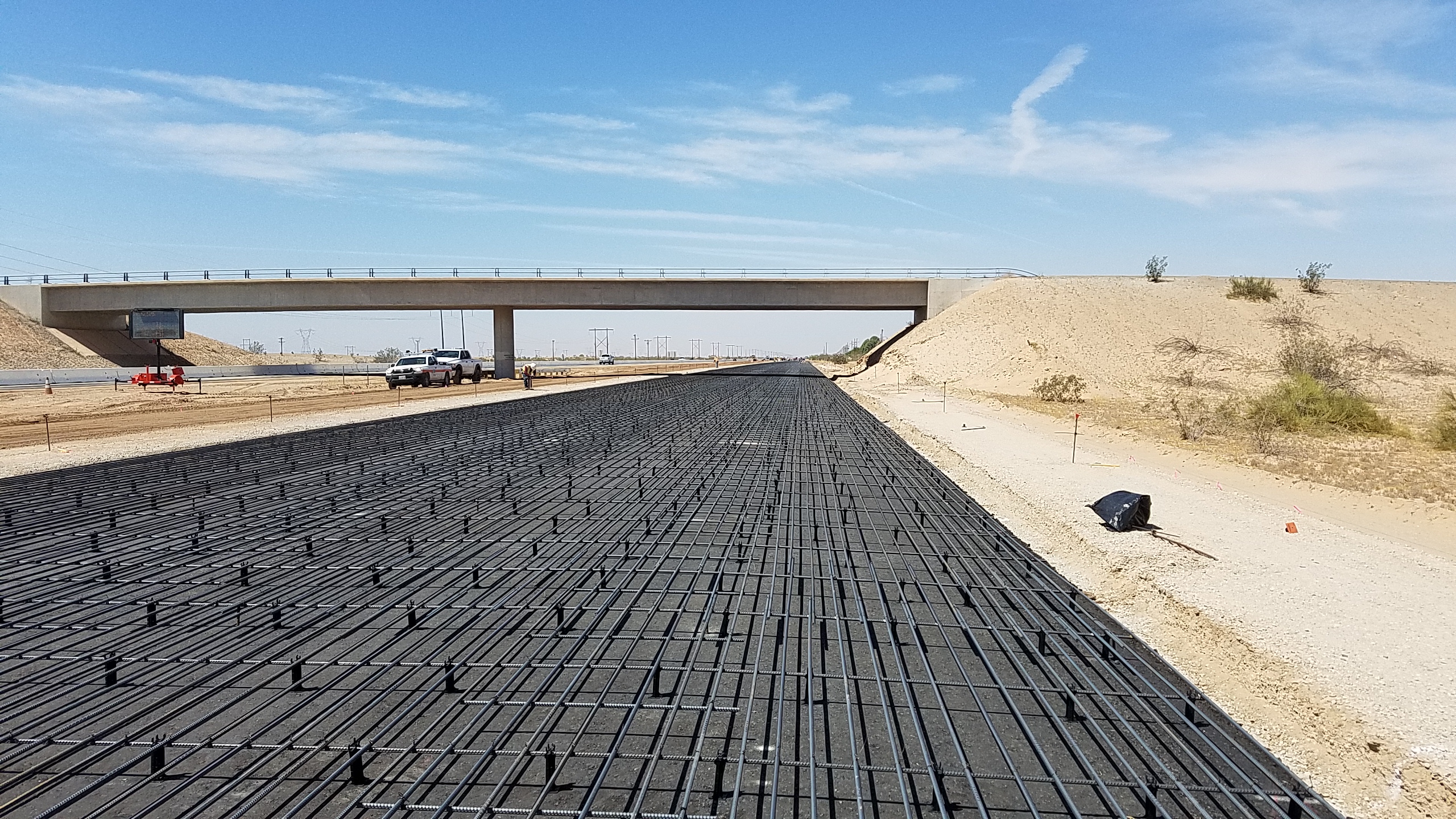
I-8 covers 287 miles, connecting San Diego to Arizona, with the Imperial County section constructed during the late 1960s and early 1970s. The aging concrete pavement in this section is impacted by a high percentage of truck volume at 26.1%, and further stressed by the harsh climatic conditions typical of the southwest desert. Caltrans noted that the original JPCP has become distressed and asphalt shoulders have been repeatedly sealed and repaired.
Over the years, to extend the life of the mainline pavement, isolated concrete panels were replaced and the roadway was diamond ground to improve ride quality, but after 50 years of service, Caltrans determined that continuing repairs would result in diminishing returns. Further repair work would increase personnel exposure to traffic and also inconvenience the public.
“Some of the cracks were at Stage 3, close to failure – it’s the worst stage of cracking,” said Oreiro.
It was logically concluded that the issues with poor ride quality, third-stage cracking, and frequent maintenance required the pavement to undergo a full rehabilitation of the existing 8.4”-thick JPCP.
The projects took place between May 2015 and December 2019 with the work divided into five segments. The first three segments began construction in early 2016, with Segments One and Two completed in 2017 and Segment Three in 2018. These segments were fully reconstructed with CRCP. Then Coffman Specialties (Segment Five) and Security Paving (Segment Four), via contracts totaling $151,000,000, broke ground on both segments in July 2019. The work included more than one million square yards of CRCP overlay.
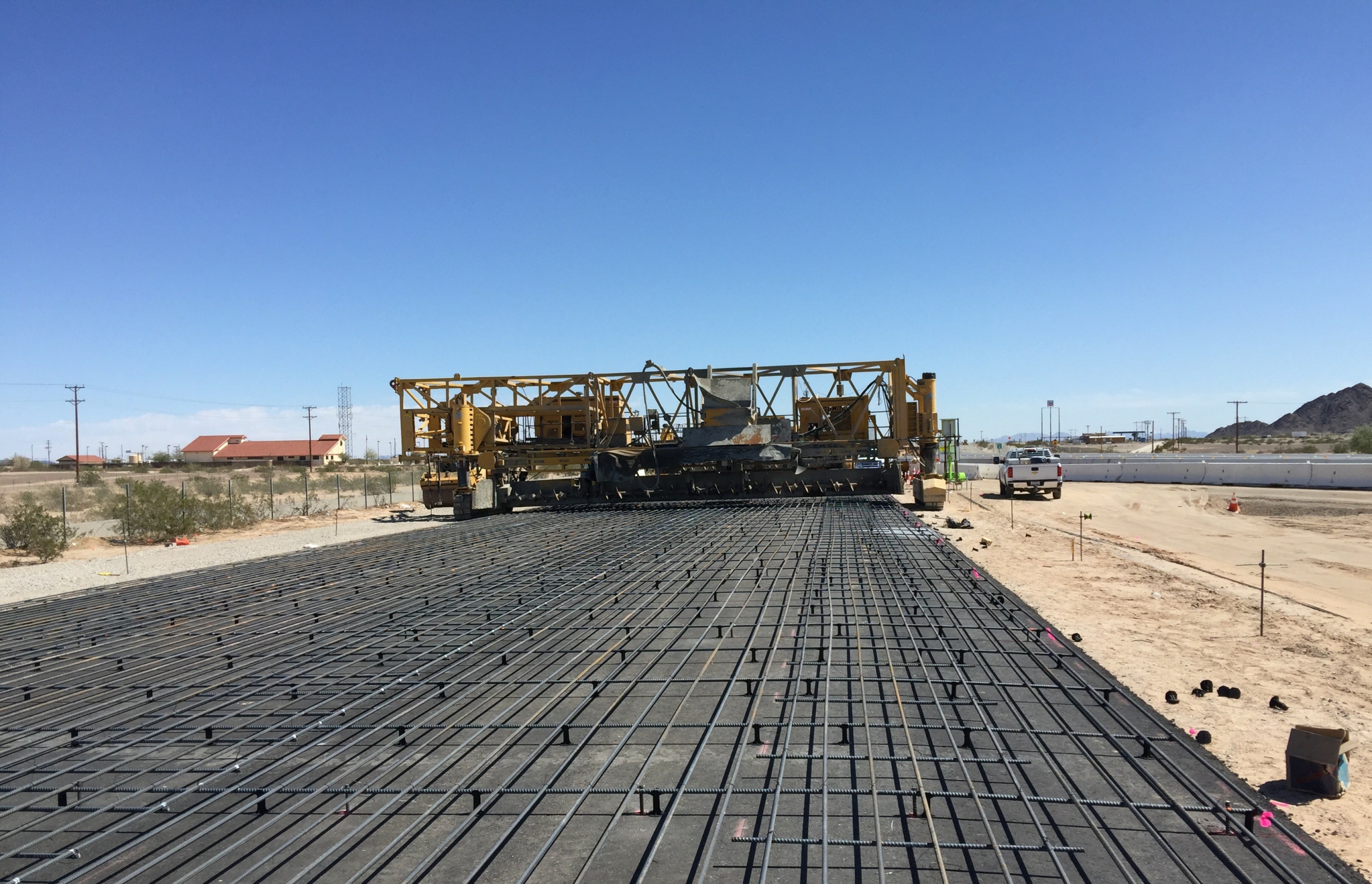 Completed on December 15, 2019, the work of Security Paving and Coffman Specialties successfully overlayed pavement on a total of 88 lane-miles of the highway, asphalt shoulders, and gore areas, with the CRCP including an HMA interlayer. This resulted in a continuous, smooth-riding surface capable of withstanding the heaviest traffic loads and the most adverse environmental conditions.
Completed on December 15, 2019, the work of Security Paving and Coffman Specialties successfully overlayed pavement on a total of 88 lane-miles of the highway, asphalt shoulders, and gore areas, with the CRCP including an HMA interlayer. This resulted in a continuous, smooth-riding surface capable of withstanding the heaviest traffic loads and the most adverse environmental conditions.
The new upgraded pavement and shoulders will require very little maintenance compared to the prior pavements, and the lifespan for the CRCP has been estimated at 70 years, far exceeding the life of the original road surfaces.
Data on Segments Four and Five
The CRCP-overlay specifications required repairs to be completed on the existing PCC pavement before the 0.2’ HMA interlayer was paved. The contractors completed work on the existing PCC pavement to repair spalls, cracks wider than 0.25”, and loose pavement prior to placing an overlay. Punch-outs and broken slabs were removed and replaced with JCPC. The overlay raised the grade by 0.95 foot (HMA interlayer plus CRCP overlay), which required the addition of embankment to meet the new shoulder elevation. Material recycled from Segments One, Two and Three, totaling more than 200,000 cubic yards of roadway excavation material consisting of all the crushed PCC pavement and pavement grindings, were used for this purpose and was designated as imported borrow and Class 2 base. The excavated materials had been stockpiled in nearby locations.
Recycling was factored into the design.
“One hundred percent of the old pavement was re-used and put back in the project and this led to significant cost savings,” said Oreiro. “With the existing JPCP functioning as a pavement base layer, there was zero waste and no processing required of the old concrete pavement. This resulted in the conservation of virgin aggregates, elimination of deposits at disposal sites, and reduction of the need to transport construction materials. These reductions led to decreases in greenhouse gas emissions and traffic congestion. We raised the roadbed, so we needed some shoulder backing to not have a bump in between the existing shoulder backing.”
“It was not an option for them,” said Daniel Hernandez, the Resident Engineer for Segments Four and Five. “That was great. They had to crush all the concrete.”
The CRCP design was optimized at Caltrans HQ by their pavement division using ASHTTOW Pavement-ME design software. This allowed the project design engineer to develop a more efficient pavement design with equal or better performance compared to the standard designs found in the Caltrans Highway Design Manual. The Traffic Index (TI) for the project was 13.
Parvini had done some design work on the structural section of the project to optimize overlay thickness for the traffic and environmental conditions. As the work took place in desert terrain, raising the elevation of the roadway was not a huge issue, compared to an urban area.
A typical structural section for the overlays consisted of 0.75’ of CRCP, 0.20’ of HMA interlayer, 0.7’ of existing PCC, 0.45’ CT and 0.25’ AB of existing base, and 0.5’ AS of existing subbase.
Design analysis and Life Cycle Cost Analysis by Caltrans determined the preferred pavement option as the CRCP overlay that has lower present value costs over the 50-year-analysis period. The cost for the Crack Seat Flexible Overlay (CSFOL) alternative was more than double the CRCP overlay cost, and user costs for the CRCP overlay are lower as well. As CRCP does not have transverse joints, current long-term issues, such as thermal curl, leading to first- and third-stage cracking and poor ride quality, were minimized. CRCP shoulders were deemed by Caltrans to be more durable in the desert climate compared to the in-place asphalt place or an HMA replacement.
Retaining the existing pavement added to the structural integrity of the new pavement. Using it as a base resulted in cost savings of approximately $250,000-per-lane-mile compared to full reconstruction.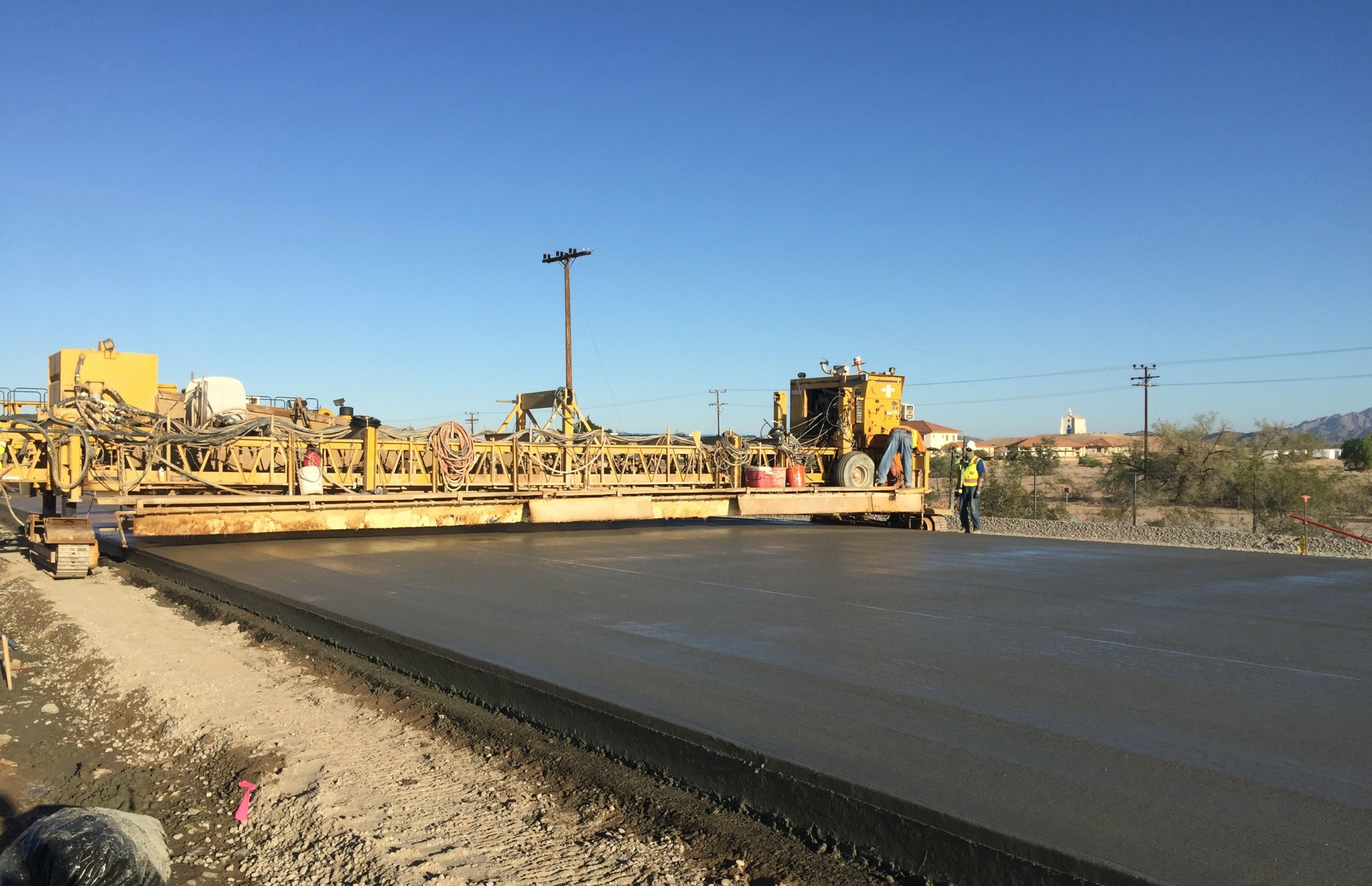
Serious planning went into the costing, innovations, and scheduling of the work.
Segment Four, 15.1 miles, was divided into two sections as the middle section had been reconstructed, and Segment Five, 6.9 miles, was continuous.
Developing a traffic management plan was a crucial first step, as several segments were being constructed simultaneously.
“The staging was similar to the first projects,” said Oreiro. “We reduced traffic flow in one lane in each direction and moved it over to the other side while the crews did the overlay. That was innovative as we usually don’t do that in District 11. In the Segment Four area, there’s the Evan Hughes Highway parallel to the straight-of-way and we put westbound traffic on it, so we didn’t reduce traffic capacity. The plan also provided closure charts for the freeway and ramps that were coordinated with the other projects.”
Keeping the public informed about the need for the project and the construction schedule was also important, and the Final Community Involvement Plan included an extensive communication plan in which various stakeholders were identified and kept updated throughout the life of the project.
The safety plan included public information, construction bulletins, portable changeable message signs, temporary radar feedback signs, and incident management such as the Construction Zone Enhanced Enforcement Program and the use of a tow truck service patrol.
“The safety team also developed strategies to deal with traffic incidents, detailing how traffic would be re-directed to alternate routes, should the need occur,” said Oreiro. “A plan for bicyclists, where allowed on outer freeway shoulders, was developed and implemented, and now the county has that added benefit for cyclists.”
“Caltrans State Highway Operations Program (SHOPP) had some extra money left over from previous years and we were able to use it on this project because the pavement was past its design life,” said Oreiro. “We wanted to come up with something innovative and not affect the traveling public. This is a very big farming/produce area and it’s an essential trade corridor. We connect to Yuma on the east side and El Centro to the west, and that connects to Mexico down south on SR 111. The pavement was worse for the first three segments, so the cost benefit analysis determined that the best option was to replace it.”
“Segments Four and Five were not as damaged,” he added, “and doing the overlay showed a better cost savings in the long run. Extending the lifespan by 40 years is already saving us money, and if it lasts 50, 60, 70 or 80 years, that saves us even more, not to mention the maintenance cost savings.”
Pavement overlay transitions were constructed at the beginning and end to tie into the existing roadway, and also at the interchange ramps to tie into the existing ramp grades. As the existing ramps are asphalt, transition pavement of rubberized HMA (Gap Graded) was used.
Due to an innovative and well-orchestrated staging plan, both general contractors were able to pave 39 feet wide. The plan included the use of crossover ramps to convey traffic from two roadbeds onto a single, shared roadbed.
“This allowed unused roadbed to easily be rehabilitated,” said Oreiro. “When one side was complete, the process was repeated on the remaining side. Over a large portion of the project, traffic for one direction of the two-lane highway was moved onto the county road that parallels
I-8. This was proposed by the contractors and turned out to be a successful strategy by improving safety, reducing congestion, and accelerating the schedule.”
Paving 39 feet wide with slopes had its complications.
“When you were coming to a ramp,” said Manuel Plancarte, Caltrans Overlay Inspector for Segment Four, “there were different slopes. But on the straightaways, there were breaks of five and two percent on the outside. It was continuous like that for a while. The gores, the transitions on the slopes, had to be planned for the setting of the forms.”
“A lot of projects don’t pave the gores with concrete,” added Oreiro. “I elected to do this here because the ramps are still HMA as you go further and once you get to the 30-foot point, it’s concrete paved all the way. We made it HMA after that because when they have to rehabilitate the ramps, if I did not do the gores in concrete, then maintenance crews would have to disrupt freeway traffic to work on the ramps in the future. If you could close the ramp and not even expose the maintenance crews to traffic, that is a plus in my book.”
“The paving crews averaged between 2,000 and 2,500 linear feet of pavement a day,” Oreiro stated.
The smoothness of the upgraded lanes was a critical factor in the contract specifications, and having incentives and disincentives helped keep the contractors focused on delivering a smooth pavement with good ridability.
As the work progressed, administrative changes were made regarding the staging.
“We found room for improvement,” said Daniel Hernandez. “We had some change orders to re-arrange the sequence, especially on Segment Five, which allowed the contractor put in a lot of resources and open the freeway to traffic a year ahead of schedule.”
The freeway is located along a fault line separating the California and North American plates, which required the placement of expansion joints. “One side is moving south and the other side is moving north,” stated Oreiro. “We really can’t do much else, and we’ll see if it will hold for a while. The seismic fault there moves three to seven centimeters a year.”
On Segment Five, there is a casino off of the Colorado River and Caltrans had to keep the ramps open to maintain good relations with the Quechan Tribe, as well as with the California Highway Patrol, which requires access to the freeway for emergencies.
Batch plants were set up in both segments. The batch plant for Segment Five was placed in the middle of the median by Coffman Specialties.
“With permission from the regional water board, Coffman dug a well, which enabled them to supply the plant with water in the middle of the desert,” said Oreiro.
“One of the options they explored was getting water from the nearest farm, a few miles away,” said Hernandez. “It was cheaper for them to drill a well.”
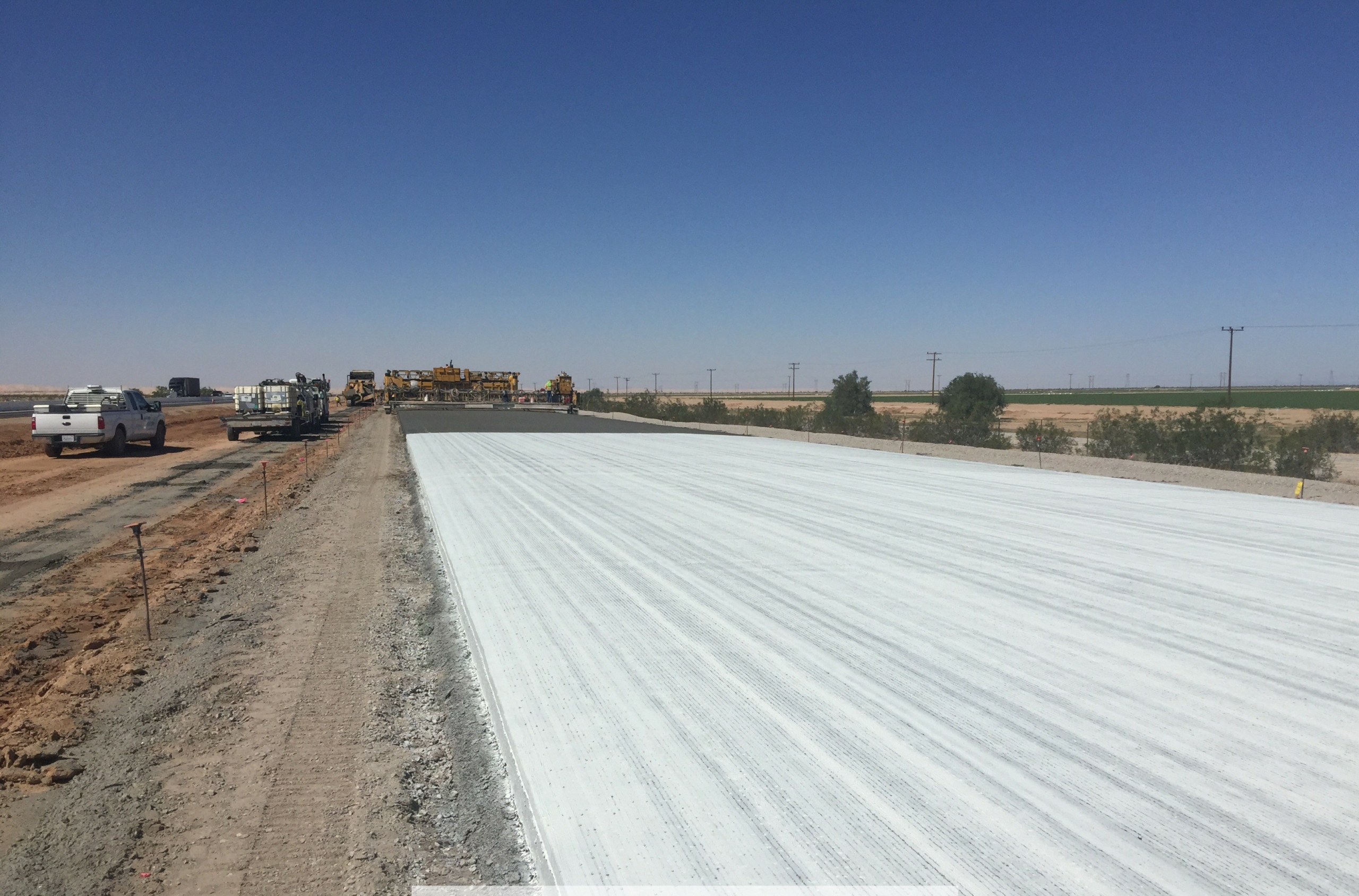 Other members of the Caltrans team included Design Manager Donaldo Martinez and Project Manager Ismael Salazar, both for all five segments, along with Dulce Rufino Feldman, Ph.D., P.E., Caltrans Senior Concrete Pavement Design Engineer, Division of Maintenance, MS-91, Office of Concrete Pavements.
Other members of the Caltrans team included Design Manager Donaldo Martinez and Project Manager Ismael Salazar, both for all five segments, along with Dulce Rufino Feldman, Ph.D., P.E., Caltrans Senior Concrete Pavement Design Engineer, Division of Maintenance, MS-91, Office of Concrete Pavements.
Shawn Rizzuto, Construction Engineer (Imperial County); Alberto Gayoon, Maintenance Engineering; Rosita Sisson, Design Staff; Chi Vargas, District Native American Liaison; Dave Evans, District Materials Engineering; Russell Simpson, Environmental Analysis – Branch B; Danny McClure, Traffic Electrical Design; Seth Cutter, District Bicycle Coordinator; Ajmail Zulali, District TMP; Diane Vermeulen, District, Hazardous Waste Studies; Kinze Monololo, District Right of Way; and Roya Yazdanifard, District NPDES/Stormwater.
Future CRCP Overlay projects are being by Caltrans in other Districts.
Oreiro would like to see Caltrans consider CRCP overlays used on future projects. “I could use this as a starting point and see if it applies to new projects that we’re doing,” he said. “We’re not building a lot of new roads anymore – we’re fixing what’s there and making the roads better. We can try to make a template, but in San Diego and other urban areas, you have to change the strategy. No matter where we’re working, we’re always going to be mindful of sustainability, trying to make things last longer, and looking after the safety of our maintenance crews.”
Planning is ongoing for a reconstruction and rehabilitation of I-10, another desert highway that runs from Indio to the Arizona border, which will likely include placing a concrete overlay on top of the existing asphalt.
Within District 11, Segments Four and Five won the Partnering Success in Motion Award, and Segment Five just received Gold in Excellence in Partnering, a state-wide recognition. “That was a major accomplishment,” said Hernandez, “and Segment Four may complete for that award next year.”
Charles Stuart, the Executive Director of the Southwest Concrete Pavement Association, who participated in the discussion, appreciated the efforts of the Caltrans team.
“When you can leave the old pavement in place, you can save a lot of money, primarily on excavation,” he said. “This leads to thinking about sustainability. When you’re not taking pavement out, you don’t have to plan on what to do with the waste. We need this kind of thinking on more projects. We don’t hear enough about reusing and recycling materials.”
“It gets more challenging when you’re in urban areas,” Stuart added, “but we have to get into a mindset where designers are thinking about long life spans, safety, reducing maintenance, and finding places to reuse recycled materials.”


